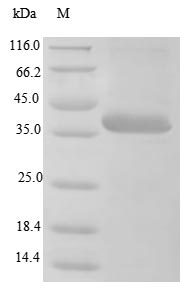Recombinant BK polyomavirus Minor capsid protein VP2 is produced in E.coli and includes the full-length mature protein from amino acids 2 to 351. The product comes with an N-terminal 10xHis-tag, which makes purification and detection more straightforward. SDS-PAGE analysis shows purity levels exceeding 85%, though this should provide adequate reliability for most research applications. This product is designed strictly for research use and cannot be used for clinical or diagnostic purposes.
The Minor capsid protein VP2 of BK polyomavirus appears to play an important role in the viral life cycle. It likely contributes to both assembly and stability of the viral capsid structure. VP2 seems to be involved in the encapsidation of viral DNA—a process that may be essential for creating infectious virions. Research into VP2 could potentially offer valuable insights into polyomavirus biology and how these viruses interact with host cells, which might advance our understanding in virology research.
Potential Applications
Note: The applications listed below are based on what we know about this protein's biological functions, published research, and experience from experts in the field. However, we haven't fully tested all of these applications ourselves yet. We'd recommend running some preliminary tests first to make sure they work for your specific research goals.
BK polyomavirus Minor capsid protein VP2 is a structural protein that requires precise folding, proper oligomerization, and specific tertiary structure for its functional activity in viral capsid assembly. The E. coli expression system may not provide the eukaryotic folding environment or post-translational modifications required for optimal function. The N-terminal 10xHis-tag may cause steric interference with the protein's oligomerization interfaces or functional domains. While the full-length mature protein (2-351aa) contains all functional domains, the probability of correct folding with functional capsid assembly activity requires experimental validation. Without verification, the protein may be misfolded and non-functional.
1. Viral Capsid Assembly and Structure-Function Studies
This application carries a significant risk without functional validation. VP2's role in capsid assembly requires proper folding and oligomerization with other capsid proteins (e.g., VP1). If correctly folded and active (verified through assembly assays), the protein may be suitable for structural studies. If misfolded/inactive (unverified), assembly studies will yield biologically meaningless results. The His-tag may sterically interfere with native protein-protein interactions.
2. Antibody Development and Immunological Assays
This application is highly suitable as antibody development relies on antigenic sequence recognition rather than functional protein folding. The full-length mature protein provides comprehensive epitope coverage for generating VP2-specific antibodies. The high purity (>85%) ensures minimal contamination-related issues during immunization protocols.
3. Protein-Protein Interaction Studies
This application requires proper folding validation. VP2 interactions with host proteins or other viral capsid components require precise tertiary structure. If correctly folded (verified), the protein may identify physiological interaction partners. If misfolded/unverified, there is a high risk of non-specific binding or failure to replicate genuine interactions.
4. Biochemical Characterization
Studies should focus on folding stability (e.g., circular dichroism, thermal shift assays) rather than enzymatic assays. If correctly folded (verified), biophysical analysis is valuable; if misfolded/unverified, results describe an artificial construct.
Final Recommendation & Action Plan
The E. coli-expressed VP2 with His-tag may not be properly folded for functional studies without experimental validation. Begin with biophysical characterization (Application 4) to assess folding quality through techniques like circular dichroism spectroscopy and size-exclusion chromatography. Validate capsid assembly capability through electron microscopy or co-expression with VP1 before considering Applications 1 and 3. Application 2 (antibody development) can proceed immediately. For reliable VP2 research, use mammalian expression systems that support proper folding and oligomerization, or verify functionality in vitro with positive controls.






